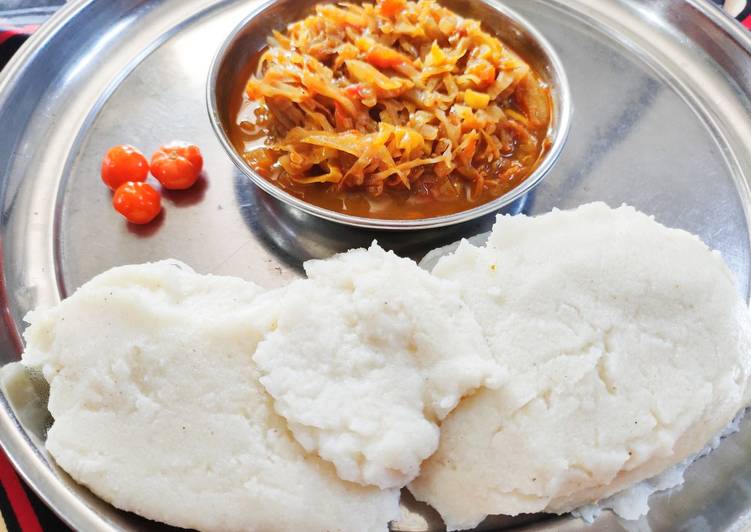Nsima ndi Ndiwo - . Today I am sharing this Nsima ndi Ndiwo! A quick and easy dinner that is ready in under 20 minutes! Malawi is a small rural country in Africa. Nsima is a staple food of of Malawi. It is the most famous among all the traditional dishes and is loved. Ndiwo is a simple Zambian dish that is typically prepared with various leafy green vegetables, onions, and optionally tomatoes. The choice of greens may include anything from cassava leaves, collard.
 In Malawi, barbecued fish is served with nsima - a Malawian staple traditionally made from maize flour.
It becomes quite firm after cooking and is traditionally served as a kind of large patty cake.
Nsima and chambo is also best served with beans and other vegetables.
In Malawi, barbecued fish is served with nsima - a Malawian staple traditionally made from maize flour.
It becomes quite firm after cooking and is traditionally served as a kind of large patty cake.
Nsima and chambo is also best served with beans and other vegetables.
You can cook Nsima ndi Ndiwo with 15 Ingredients and 9 steps. See the following guide!
Ingredients for Nsima ndi Ndiwo:
- For nsima-.
- 3/4 cup white maize flour.
- 2 cups water.
- For ndiwo-.
- 2 cups shredded cabbage.
- 2 tbsp oil.
- 3 cloves garlic chopped.
- 1 medium size onion.
- 1 medium to big tomato.
- 1 pinch garam masala.
- 1 pinch turmeric powder.
- 1/2 tsp dhanajeera powder.
- 1 tsp chilli powder.
- As per taste Salt.
- 1 packet Maggi magic masala (optional).
The most famous hotels in Nsima is thickened porridge made from maize, a crop which is widely grown in the country and is one. DescriptionFriends at Chikondi Malawi eating nsima, ndiwo and masamba.jpg. nsima. smile. Ugali, also known as ugali pap, nsima and nshima, is a type of maize flour porridge made in Africa. It is also known as ngima, obusuma,obuchima, kimnyet, nshima, mieliepap, phutu, sadza, kwon.
Step by step how to cook Nsima ndi Ndiwo:
- Introduction to typically Malawian items.1. The wooden spoon - this spoon is used to mix flour and water while cooking nsima. The flat side of it helps to break the lumps while rubbing it against the wall of a pot. 2. Kambuzi chilli - these tiny orange chillies have altogether a different flavour and it's super hot. They give very typical taste to the dish. It is often pickled in vinegar and served..
- Making nsima takes only 10 mins. Take 2 cups of water in a thick pot. Heat it till it is warm. Sprinkle half of the maize flour over the warm water and mix it well to make it lump-free..
- Cover and cook for about 5 minutes on low heat. Open the lid and check the consistency- see photo no.2. the mixture should be forming big bubbles popping out and should look thick like raab/porridge. Add the rest of the flour, a little at a time and mix..
- Mix it round and a portion of it can be rubbed against the pot wall to break the lumps. Continue to mix until the mixture looks lump-free..
- Cover the pot and cook it over a grill for another 3 minutes. Open and give it one more stir..
- Serving - dip a small dish in water and scoop out nsima. Place it in a food warmer or a serving plate. Keep it covered in order to avoid dry surface and hard texture. It is best eaten hot..
- Ndiwo - heat 2 tbsp oil. Fry onions and garlic. Then add tomatoes and fry till they are soft. Add spices and fry a little. Add cabbage and mix well..
- Add water till the level of cabbage. Cover and cook on low heat till cabbage is cooked till soft. you may add water in between if it gets dry. The Ndiwo must have some curry while serving..
- How to eat - traditionally, the Malawians pinch out a portion of nsima and smoothen it by working with it between the finger and palm (as if making muthiya). You can also work against the plate surface, to be civilized. Then they dip it in the Ndiwo, pick some ndiwo along with it and eat..
Koma nsima ndi yosiyana mitengo. chifukwa cha mbale. Mbale yaikulu ya nsima ndi ndalama zingati? Nsima or ubwali, buhobe - Zambia (Different regions, groupings or tribes use different names) Nshima (spelt with an H) is more like a slang used mostly when people are speaking English. Salam Aleykum Oxumağa deyer olmuş hadısedi. Dayım qızı cazibedar celb edici qızdı Götü sinesi çox yekedi mence bir çox.